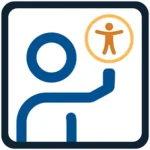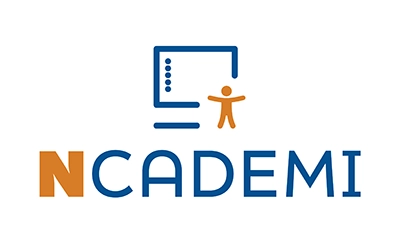Two Sets of Indicators
The QIs are presented in two different sets, reflecting the different laws that guarantee students with disabilities access educational material. To determine which set to prioritize for your setting, compare the sets of Quality Indicators and explore the Decision-making Guide below.

Quality Indicators for the Provision and Use of Accessible Digital Educational Materials
These indicators are aligned with the Americans with Disabilities Act (ADA) Title II final rule, Nondiscrimination on the Basis of Disability: Accessibility of Web Information and Services of State and Local Government Entities.
In an ideal system, digital accessibility is prioritized, resulting in the consistent provision of edtech products and digital materials that are accessible for students with disabilities from the beginning. This ensures immediate access and reduces the need to create accessible formats of non-accessible materials.
This set of indicators supports agencies with creating and sustaining such systems and is referenced as the “Quality Indicators for Accessible Digital Materials.”

Quality Indicators for the Provision and Use of Accessible Formats
These indicators are aligned with the Individuals with Disabilities Education Act (IDEA).
When SEAs or LEAs procure print materials, students with sensory, physical, and learning disabilities will require accessible formats. Under IDEA, SEAs and LEAs must provide these formats in a timely manner when an IEP team determines a qualifying student needs a specific format (e.g., braille, digital text, large print, or audio).
This set of indicators supports agencies with creating and sustaining systems for providing accessible formats. It is referenced as the “Quality Indicators for Accessible Formats.”
Quality Indicators Comparison Table
To decide which set of Quality Indicators to prioritize, explore the distinctions between each set below and review the Decision-making Guide to choose the best path for your agency.
| Comparison Factor | Quality Indicators for Accessible Digital Materials | Quality Indicators for Accessible Formats |
| Legal Foundation | Americans with Disabilities Act (ADA) Title II | Individuals with Disabilities Education Act (IDEA) |
| Primary Students Served | All students, staff, and parents/caregivers with disabilities | Students who are dually eligible to receive accessible formats under IDEA and Section 121 of the U.S. Copyright Act (Chafee Amendment) |
| Beneficiary Impact | Universal benefit for all users with disabilities | Targeted benefit for specific students with identified needs |
| Primary Focus | Prevention of accessibility barriers | Remediation of existing accessibility barriers |
| Timing and Approach | Proactive accessibility – materials accessible from the beginning | Reactive accessibility – materials converted to accessible formats on an as needed basis |
| Examples of Material Types and Scope | Websites, apps, digital textbooks, multimedia, online platforms, and edtech tools | Print materials converted to accessible formats (e.g., braille, digital text, large print, audio). |
| Technical Standards | WCAG 2.1 Level AA | National Instructional Materials Accessibility Standard (NIMAS) |
Decision-making Guide
The purpose of this guide is to help an agency determine which set of Quality Indicators to prioritize for implementation. In the process of using this guide, an agency may decide to focus on specific Quality Indicators of both sets.
Path 1: Improve Digital Accessibility
Goal: To ensure all digital educational materials and tools are accessible to students with disabilities from the beginning. This aligns with the ADA Title II Final Rule which requires state and local government entities, including SEAs and LEAs, to ensure their web content and mobile apps meet WCAG 2.1 Level AA. This guarantees access for all students, staff, and parents and caregivers with disabilities.
Decision Point: Are you focused on ensuring your agency’s websites, apps, digital textbooks, multimedia, etc. are accessible?
- If YES: Focus on Quality Indicators for Accessible Digital Materials (Path 1) or consider Path 3
- If NO: Consider Path 2, focusing on the Quality Indicators for Accessible Formats
Path 2: Improve the Provision of Accessible Formats
Goal: To ensure students with disabilities who need accessible formats (e.g., braille, large print, audio, digital text, and tactile graphics) get them in a timely manner. This aligns with IDEA which requires agencies to provide accessible formats of non-accessible educational materials (mainly print) to students with IEPs who require them as part of their Free Appropriate Public Education (FAPE).
Decision Point: Are you focusing on materials such as print-based textbooks and/or materials students can’t access without conversion?
- If YES: Focus on Quality Indicators for Accessible Formats (Path 2) or consider Path 3
- If NO: Re-evaluate your primary goal to determine your agency’s priorities for improving the accessibility of materials provided to students.
Path 3: Comprehensive Implementation
Goal: To ensure complete accessibility across all educational materials and platforms, addressing both immediate conversion needs for print materials for students with disabilities and long-term digital accessibility from the beginning.
Decision Point: Do you want to create a comprehensive accessibility system by integrating indicators from both sets based on your agency’s needs and priorities?
- If YES: Consider using the flexible implementation strategy below to customize your approach
- If NO: Choose to focus on one set first using Paths 1 or 2, with plans to expand later
Implementation Strategy: Since several Quality Indicators overlap between the two sets, agencies can create a customized implementation plan by selecting relevant indicators from both sets. Consider this flexible approach:
- Identify Overlapping Areas: Review both sets to find common indicators (e.g., leadership commitment, staff training, policy development)
- Integrate Complementary Elements: Combine digital accessibility planning with accessible format systems where they naturally align
- Prioritize Based on Need: Select Quality Indicators from either set based on your agency’s immediate priorities and existing gaps
- Build Systematically: Create a unified accessibility system that draws from both sets rather than maintaining separate parallel processes
- Monitor Progress: Track progress across all selected Quality Indicators to measure comprehensive accessibility improvements
